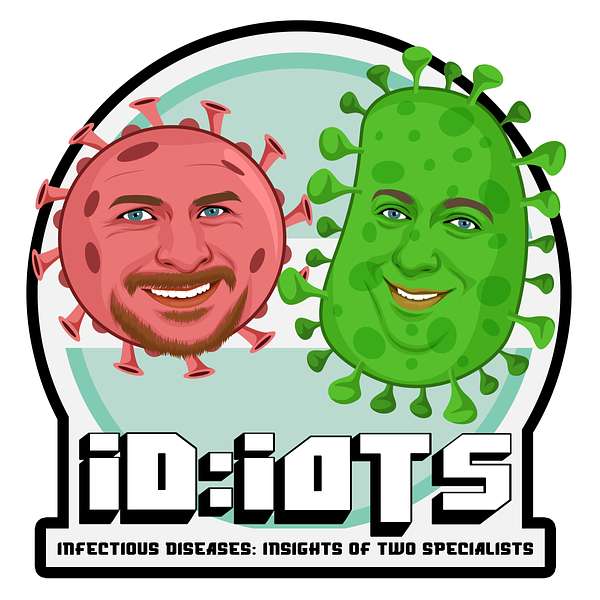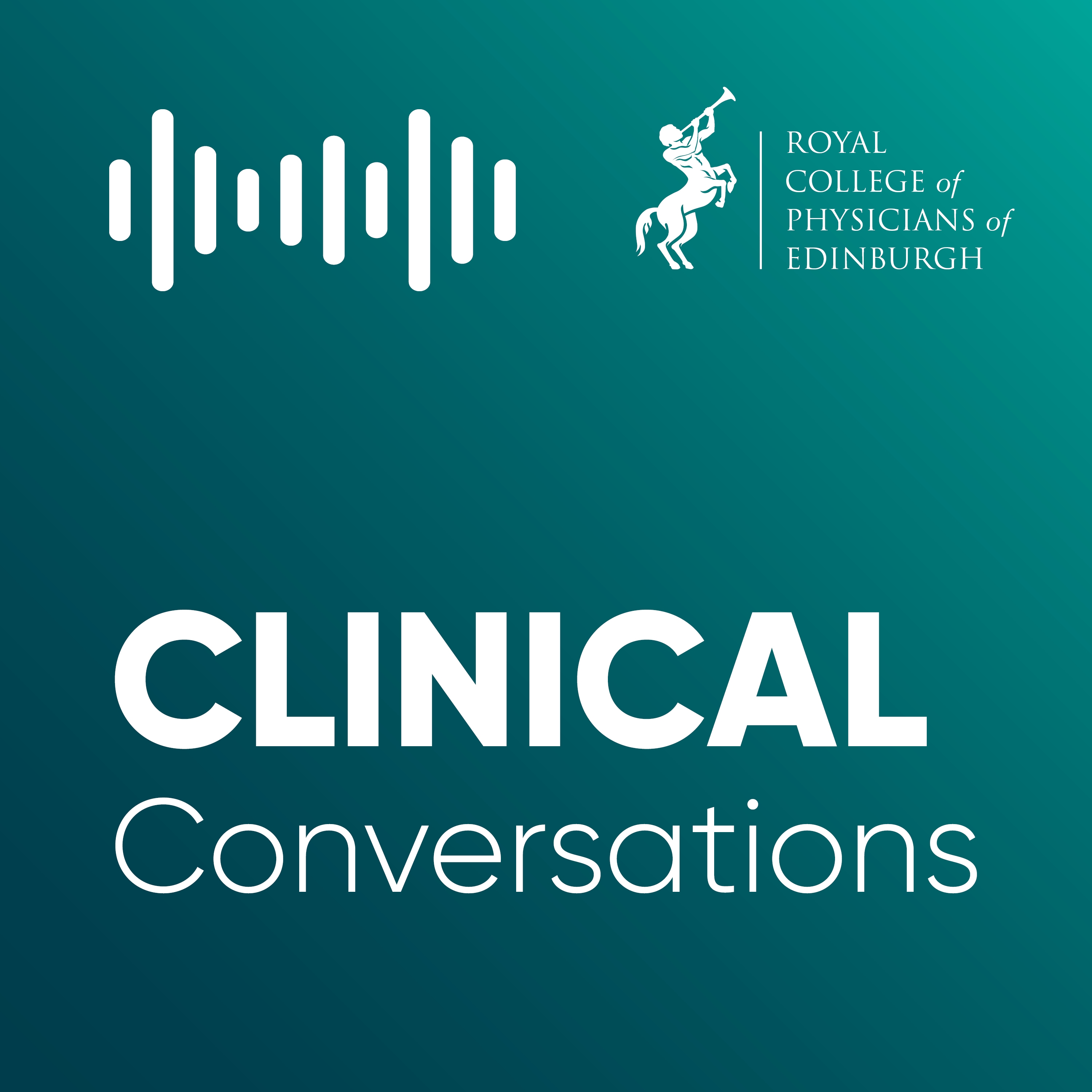
ID:IOTS - Infectious Disease Insight Of Two Specialists
Join Callum and Jame, two infectious diseases doctors, as they discuss everything you need to know to diagnose and treat infections. Aimed at doctors and clinical staff working in the UK.
Episode notes here: https://t.ly/8DyqW
Queries, comments, suggestions to idiotspodcasting@gmail.com
ID:IOTS - Infectious Disease Insight Of Two Specialists
89. Moraxella catarrhalis
Moraxella means more moronic puns from Jame&Callum. A short episode for some short rods. Listen to hear about this coccobacillus, how to identify it in the lab and what sort of clinical syndromes it causes.
Show note for this episode here
Questions, comments, suggestions to idiotspodcasting@gmail.com or on Bluesky @idiots-pod.bsky.social
Prep notes for completed episodes can be found here (Not all episodes have prep notes).
If you are enjoying the podcast please leave a review on your preferred podcast app!
Feel like giving back? Donations of caffeine gratefully received!
https://www.buymeacoffee.com/idiotspod
Callum, when I'm flying to the other side of the world, like in Southeast Asia, and I'm going through the Middle East, I don't go through Dubai Airport. It's Qatar always. And what a coincidence that is, Callum, because what are we discussing today?
callum_1_09-24-2024_222343:Jame, that, that pun and I've been thinking recently with the editing that I need to be a bit more strict with the edits and take out some
jame_1_09-24-2024_222349:Oh, you do, do you?
callum_1_09-24-2024_222343:Not mine, I don't have any
jame_1_09-24-2024_222349:not. No, no. Bear to the thought.
callum_1_09-24-2024_222343:I'm just going to axe a bit more of your stuff. I'm going to bit more axe,
jame_1_09-24-2024_222349:Huh.
callum_1_09-24-2024_222343:And I've hired someone called Ella to do
jame_1_09-24-2024_222349:god, this is nothing. What are we talking about today, Callum?
callum_1_09-24-2024_222343:Morax Ella Catarrhalis
jame_1_09-24-2024_222349:Allocateralis. And what do we know about Morax Allocateralis, Callum?
callum_1_09-24-2024_222343:I did not know much.
jame_1_09-24-2024_222349:Did you not?
callum_1_09-24-2024_222343:I've heard of it. I've seen it, treated it. I've never really borne it too much thought. If I'm completely honest, it was Just Just yes, there it is.
jame_1_09-24-2024_222349:I think maybe I thought of it mostly, I count it as the respiratory gram negatives, alongside haemophilus influenza, as something that sort of could, cause. chest infections, but I mostly think of it as like the thing that infects COPD errors and bronchiectatics, like it likes damaged lung. It doesn't like normal lung, that kind of thing. But that's not exactly true as we'll get into in a sec. So Calum, why don't you tell us a little about, about Moraxella the genus. Where does it come from?
callum_1_09-24-2024_222343:Yeah. So where it comes, it's in the order pseudo monad alleys. So that includes things like pseudo monads pseudomonas, et cetera, are non fermentors. And then the family is moraxella ca within that order. And then the Gen Gena is moraxella. and in that family there's also thing like Acinetobacter, which you'll come on to are quite similar in terms their gram stain appearances.
jame_1_09-24-2024_222349:Okay.
callum_1_09-24-2024_222343:Within the genera Moraxella, there's 22 species, 6 of which we are interested medically.
jame_1_09-24-2024_222349:Oh, now, Calum, are we going to do a Jame and Calum read the alternate names?
callum_1_09-24-2024_222343:of course,
jame_1_09-24-2024_222349:Okay, Atlantai,
callum_1_09-24-2024_222343:Catarrhalis,
jame_1_09-24-2024_222349:Lacunata, I
callum_1_09-24-2024_222343:Lincolni,
jame_1_09-24-2024_222349:non Liquefaciens,
callum_1_09-24-2024_222343:Osloensis.
jame_1_09-24-2024_222349:and that's all the species that are medically important.
callum_1_09-24-2024_222343:And from now on, we're really just going to talk about Catarrhalis.
jame_1_09-24-2024_222349:Fine, yeah, absolutely, yeah. These, I've barely had heard of any of them really. I think we've seen an Osloensis Bactrimian and an Invercompromised Perstin, Nadel, Shroyland, Fermi, North.
callum_1_09-24-2024_222343:Yeah, did they have, did they have infective endocarditis?
jame_1_09-24-2024_222349:Oh, I think so, actually, yeah.
callum_1_09-24-2024_222343:Yeah, and I think you every see, you'll often see case reports of moraxella causing invasive infections as we'll come on to.
jame_1_09-24-2024_222349:Yeah, but it's not common. This thing likes to stay in your upper respiratory tract. It will colonize your lower respiratory tract and your ears at an absolute stretch, but otherwise it's perfectly happy just sitting there not doing very much.
callum_1_09-24-2024_222343:So why is it called moraxella,
jame_1_09-24-2024_222349:Callum, it is named for Victor Morax, the Swiss ophthalmologist who first discovered the genera. And Kateralis is from the Greek tar, to flow down named after the profuse discharge from the eyes and the nose. Initially the actually the thing that we now know as Moraxella catarrhalis was called Micrococcus catarrhalis and then it was renamed Neisseria catarrhalis because it looks like Neisseria. They can present as Gram negative Diplococci and they live in the in the upper spiritual tract and that's what Neisseria do most of the time. And after that they were transferred in 1970 to a new genus called Branhamella which I've never heard of and that didn't last very long either because they then reclassified as Moraxella. And MCAT is now the name that everybody knows it as and there are two distinct catarrhalis, and one expanded into humans about five million years ago, and has a load of virulence factors, and that's the one that we that causes the lion's share of disease in humans today. So where is it, Callum, normally when it's not causing life threatening infection?
callum_1_09-24-2024_222343:Yeah, it's usually found in the upper respiratory tract. And I think the fact that an ophthalmologist was the one who first discovered it gives you a good clue as to the sort of infections it causes. So sitting around your upper respiratory tract, and as Jayme mentioned, People that COPD the immune compromised diabetes are all increased risk of getting disease. And it tends to be something that's more seen in the, the sort of younger age group or the older rather than the middle aged. It's got various sort of virulence factors that allow it to stick to cells and has some sort of proteins on its surface that allows it to do that in a similar sort of way to Haemophilus produce endotoxins, which are similar to and there, people have researched to Some people, no, and they've been found to have iron binding surface proteins, which helps with their virulence as well, and ability to acquire iron. Mentioned potential iron deficiency state being a risk factor, but Moraxella is that there wasn't that many, big recent review articles. It's, more niche, I would say. It's not something that lots of people are researching.
jame_1_09-24-2024_222349:no, I would agree with that. I think compared to, other gram negative pathogens we've mentioned, it's not a research priority, let's say. In terms of clinical syndromes, the two main ones that it cause would be otitis media and exacerbations of COPD. So from the upper respiratory tract spreading locally to the middle ear. And it causes about 15 to 20% of cases involving children. And the COPD exacerbation, they say it's responsible for about 10% of the bacterial exacerbations. No, not uncommon, let's say, and then other things that can cause bronchitis, sinusitis, laryngitis, again, spread from different bits of the respiratory tract from the upper and then community acquired pneumonia. But you generally would have to be immunocompromised in order to consider it to be. Important. And as you say, rarely or uncommonly, it can cause invasive, bloodstream infection, septic arthritis, meningitis, that kind of that kind of thing. Callum, take us through the microbiology of this thing.
callum_1_09-24-2024_222343:Yeah, I've provided a link in the notes to a website called Microbe Canvas, which has some really beautiful microscopy and agar images of this organism, so definitely check that out. The microscopy, so this is one of our Coq O Vacilli. So they can be quite variable in shape. When you look a microscope and a gram negative they're quite resistant to decolourisation on the gram, so sometimes they can appear gram positive. So they might get confused for other organisms, which we'll come on to. But the main gram negative coccobacilli that you're, or gram negative cocci, that we get confused with are Neisseria, which obviously is a worrying thing, dividing gram stains, particularly from children.
jame_1_09-24-2024_222349:Yeah, I suppose the clue there is if you're it from, sputum like context clues, et
callum_1_09-24-2024_222343:yeah, yeah, but yeah, still can be a confusing one. We'll come on to how to differentiate those organisms. More coccoid end of Coccobacilli is Moraxella carteralis, and then the other, the other, four medically important, Moraxella that we mentioned, are more rod like Usually their in pairs are short chains, so again, if it is resisting de colorization and appearing gram positive and it looks like a pair, then you might be worried about strep. And they're re teras as well. And culturally, ideally grow aerobically at 33 to 35 degrees and they're nutritionally fastidious so they don't grow well in blood agar, but that's improved in chocolate and they don't grow in McConkey. specific things about Markzell that's quite classic so they're white or buff um, and they're convex on the blood agar, and they've got this hockey puck colony so they stay intact and glide over the agar when pushed with a loop. And then to identify them so, classically, because this is on respiratory tract samples a lot of the when you've got these high respiratory tract samples and there's mixed growth, you're going to be using biochemical tests. So this is one area where we'll still be doing this quite a lot. I don't do it, but, very skilled biomedical scientists do. And the, Classic tests, so it's catalase positive, oxidase positive, and nitrate variable. It's usually beta lactamase positive. We'll come on to that. Other tests that's and might be good for exams is something called the tributurin test.
jame_1_09-24-2024_222349:So I've vaguely heard of this. Calum, like what, what is this?
callum_1_09-24-2024_222343:Yeah. So this is an, the SMI and it's a test that, looks to differentiate moraxella or vallis, which is positive from nice species, which are negative. And the other thing moraxella species are also tri bruter and positive, so it's not useful for differentiating the Marella species. But really what you're trying to do is,, is say. Is this a Moraxella or is this a Neisseria, as they both look very similar on the gram and can both be found in respiratory tract samples. With Neisseria meningitidis and other Neisseria species quite commonly in
jame_1_09-24-2024_222349:Okay. So is this like a protein or a metabolic fat or something that, that MCAT produces that Monoxella
callum_1_09-24-2024_222343:It's an enzyme, the test Works by looking if the bacteria has an enzyme hydrolysis of the, tributyrin,
jame_1_09-24-2024_222349:Oh, I see. Okay. Fine.
callum_1_09-24-2024_222343:Yeah, so that's one important Differentiator. Another thing is a DNAase test, and that differentiates Moraxella catarrhalis from other Moraxella species. So there's a flowchart in the show notes which is talking about it. Basically, you get a gram stain with gram negative large rods, or coccopacilli. You do an oxidase. If it's, Negative, you're looking at a possible oxidase negative. If it's positive, you're looking at Moraxella, some other strange things Cangella, or you might be dealing with a Neisseria. Then you do your tributarine test, and if that's positive, then it's probably Moraxella. If you do a DNAase test, and that's positive, you've probably got Moraxella catarrhales. If you do the tributary and it's negative, you're looking at probably a nice serious species.
jame_1_09-24-2024_222349:Okay, I get it. So if it's oxidase positive, tributarine positive, DNA is positive, it's MCAT. If it's oxidase positive, tributarine positive, DNA is negative, it's the non MCAT Moraxella. And if it's oxidase positive, tributarine negative, it's Neisseria species.
callum_1_09-24-2024_222343:Yes, there's lots of other organisms in there, but that's the ones you're commonly looking for.
jame_1_09-24-2024_222349:Yeah. Okay, cool, cool. Can you Maldi this?
callum_1_09-24-2024_222343:you can Maldi wherever you want, unless it's a lab pathogen, in which case don't do it. But, but yes, Maldi child works well for this.
jame_1_09-24-2024_222349:Thanks. Can I kill these bugs now?
callum_1_09-24-2024_222343:yes, how are you going to do that?
jame_1_09-24-2024_222349:I'll tell you what I'm not going to do. I'm not going to trust amoxicillin here because these things, about 90 to 99 percent of them produce a beta lactamase. So amino penicillins won't work. But penicillins with beta lactamase numbers will work just fine. And so we've got a table in the prep notes of what there are UCAS breakpoints for. And so for the penicillins, that's Ampsylbactam and Colmosaclav. The Keflasporins, it's basically the second gens and up. So there's breakpoints for Keflaroxime. Although with Oroquefroxime, the S breakpoint is 001, that's the, what they do when they want you to only use the higher dose that they're recommending. But yeah, most of the 3rd and 4th gens will work go okay. All the carbapenem as well. And then there are also breakpoints for Quinolones, from O floxacin up to Moxifloxacin. The Macrolides. Tetracyclines and Coltrimoxazole. and if you think about those things, those are the kind of things that you would be using in otitis media and COPD exacerbations and chest infections anyway. Because most of them also cover streptococci and haemophilus and things like that.
callum_1_09-24-2024_222343:Yeah, we've got quite a few options. As the betalactomases there's two bros, that big betalactomases. That's bro one and bro two, and you can decide which of those is which.
jame_1_09-24-2024_222349:Which is which, yes, exactly. And then in terms of other resistance, you can get resistance to the other drug classes that we've just mentioned. And it's a variety of mechanisms. Efflux pumps. They talk about for the, for the quinolones, they talk about GYR gene target modification, et cetera, et cetera. But really the it depends on what paper you look at, but there's variable resistance, let's say to quinolones, macrolides and coulterimoxazole. So when you, if you have a Moraxelle, it will be tested against, a bunch of the drugs that we've just mentioned. And so you'll act based on the susceptibility profile on them. I don't remember coming across a Moraxelle sample that I couldn't treat, at least in theory.
callum_1_09-24-2024_222343:Yeah, I think it's probably more of an issue in pediatrics and primary care than we used to see as infection specialists for the reason that it's not really that problematic a lot of the time in terms of it does cause a lot of disease, but the lack of resistance means it doesn't come to her, to us.
jame_1_09-24-2024_222349:true
callum_1_09-24-2024_222343:that's our rapid well, actually it wasn't that rapid, but I did get Ella to take more acts to this episode than she had before.
jame_1_09-24-2024_222349:Okay, okay,
callum_1_09-24-2024_222343:why it's so short, we edited the lot out.
jame_1_09-24-2024_222349:They don't all have to be huge, long, 50 minute, two parter, absolute multiple
callum_1_09-24-2024_222343:We're looking at you, yeah, we're looking at you, Steven Monaghan.
jame_1_09-24-2024_222349:pseudomonas, yeah. So yeah, sometimes it's just not that much to say.
Podcasts we love
Check out these other fine podcasts recommended by us, not an algorithm.

Febrile
Sara Dong
Microbe Mail
Vindana Chibabhai
Let's Talk Micro
Luis Plaza
Breakpoints
Society of Infectious Diseases Pharmacists
Clinical Conversations
Royal College of Physicians of Edinburgh